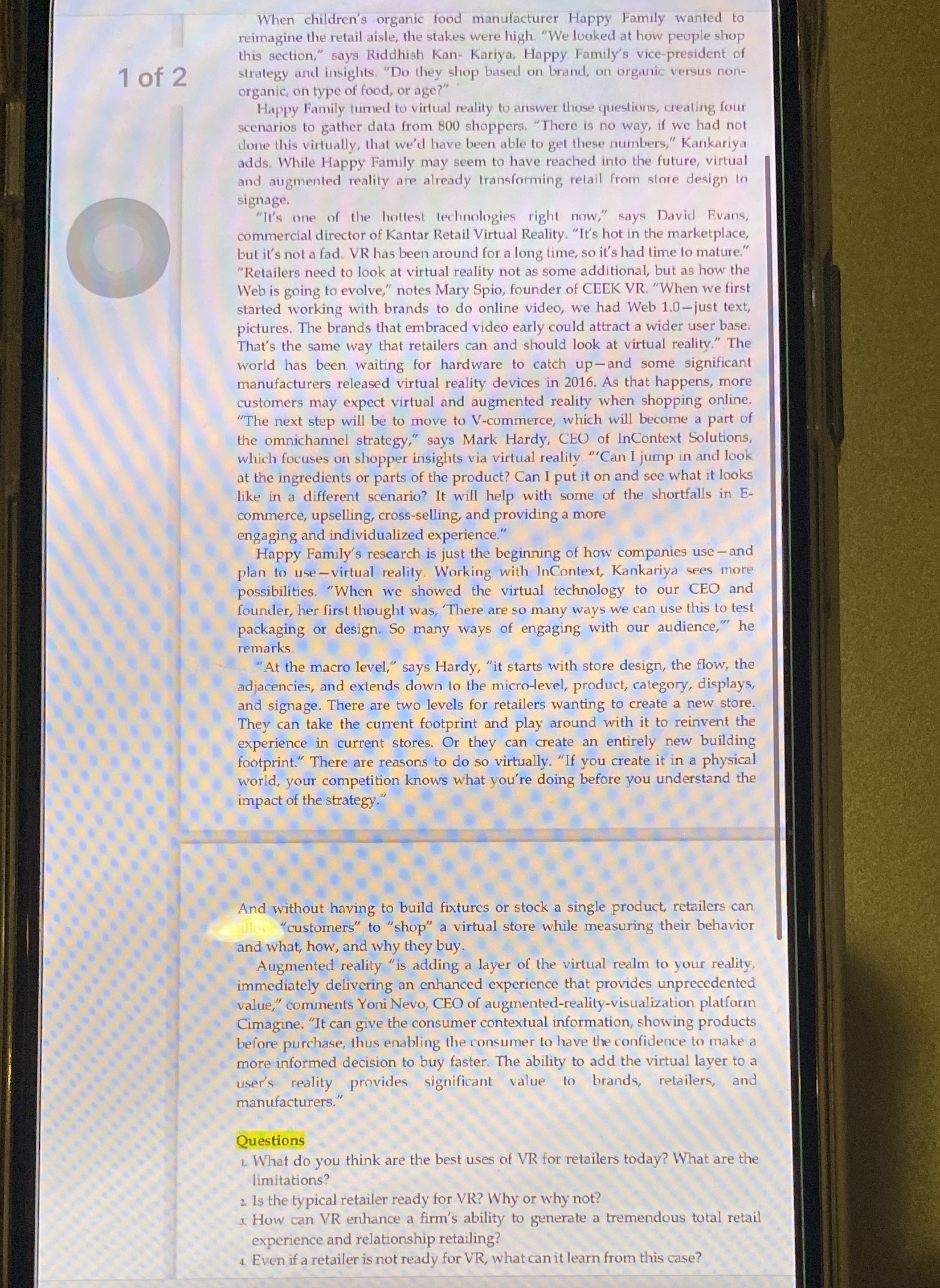see attached photo
When children's organic food manufacturer Happy Family wanted to ri-ilnagillu the retail aisle, the stakes Were high "We looked at how people shop this section." says Riddhlsh Kan- Kuriyo. Happy Family's vice-president of Istrategy ttltll ill'aiBltlS. "Do they slurp based on brand, on urgiuric versus non- orgamc, on type of food, or age?" Happy Family turned to virtual Iealily In Answer those questions, treating lulu scenarios to gather data from 800 shoppers. \"There is no way, If We had not done this virtually. that we'd have been dlllv to get these \"titular-rs," Killllkzll'lyll adds While Happy Family may seem to have reached into the future, VlrlllJi and .mgmr-nled realily are already transforming n-Iall from store design In signage. "it's one of the hottest lt't llnuiogivs right now," say- Davin] Fvnus, commercial director of Kantar Retail Virtual Reality. "It's hot in the marketplace, but it's not a fad. VR has been around fora long lime, so it's had lime to mature." "Retailers need to look at virtual reality not as some additional, but as how the Web is going to evolve,\" notes Mary Spio, founder of CEEK VR. "When we first started working:| with brands to do online video, we had Web illinst text, pictures. The brands that embraced video early could attract a wider user base. That's the same way that retailers can and should look at virtual reality." The world has been waiting for hardware to catch upand some significant manufacturers released virtual reality devices in 2016. As that happens, more customers may expect virtual and augmented reality when shopping online. "The next step will be to move to Vcummerce, which will become a part of the omnichanncl strategy," says Mark Hardy, CEO of lnContext Solutions. which focuses on shopper insights via virtual reality "'Can 1 jump in and look at the ingredients or parts of the product? Can I put it on and see what it looks like in a different scenario? It will help with some of the shortfalls in E- commerce, upselljng, cross-selling, and providing a more engaging and individualized experience." Happy Family's research is just the beginning of how companies useand plan to usevirtual reality Working with lnContexl, Kankariyd sees more possibilities. \"When we showed the virtual technology to our CEO and founder, her first thought was, 'There are so many ways we can use this to test packaging or design. 50 many ways of engaging with our audience,\"' he remarks. \"At the macro level,\" says Hardy, \"it starts with store design, the flow. the adjacenries, and extends down to the micro-level, product, category, displays, and signage. There are two levels for retailers wanting to create a new store. They can take the current footprint and play around with it to reinvent the experience in current stores. Or they can create an entirely new building footprint." There are reasons to do so virtually. "If you create it in a physical world, your competition knows what you're doing before you understand the impact of the strategy." And without having to build xtures or stock a single product. retailers can \"customers" to "shop" a virtual store while measuring their behavior and what, how, and why they buy. Augmented reality \"is adding a layer of the virtual realm to your reality, immediately delivering an enhanced experience that provrdes unprecedented value," comments Yoni Nevo, CEO of augmented-reality-visualization platform Cimagine. \"It can give the consumer contextual information, showing products before purchase, thus enabling the consumer to haw the confidence to make a more informed decision to buy faster. The ability to add the virtual layer to a user's reality provides significant Value to brand-s, retailers, and manufacturers.\" Questions L What do you think are the best usa of VR for retailers today? What are the limitations\" L 15 the typical retailer ready for VR? Why or why not? 1 How can VR enhance a firm's ability to generate a tremendous total retail experience and relationship retailing? 4. Even if a retailer is not ready for VR, what can it learn from this case







